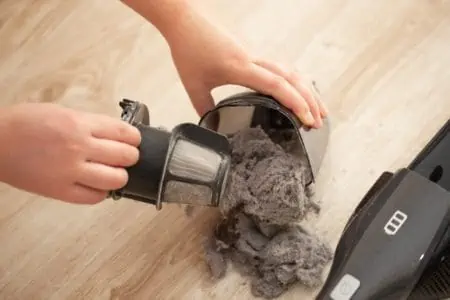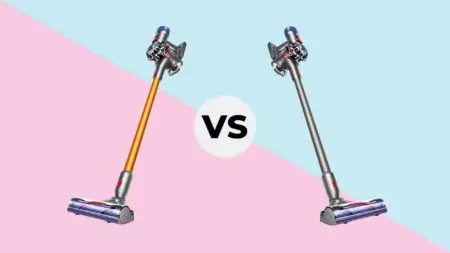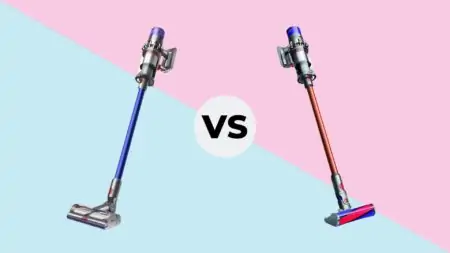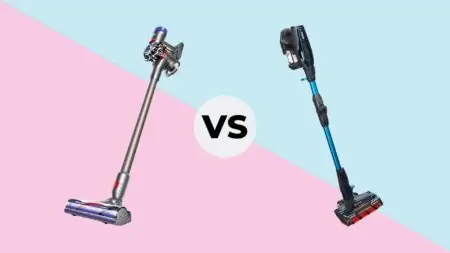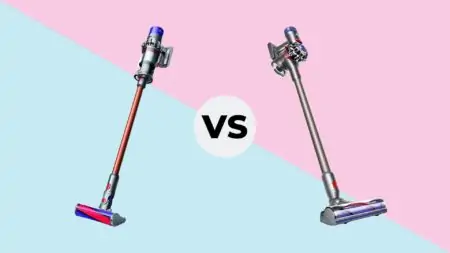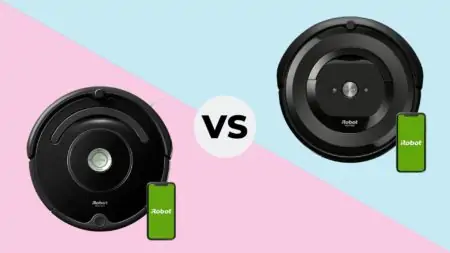We’re a bit obsessed with vacuuming here. It’s a super satisfying house chore that’s fun and easy — but when did the vacuum cleaner replace the broom? What’s the history behind the vacuum cleaner?
We’re going to share 20 vacuum cleaner facts and statistics. We’ll shed light on the history of vacuum cleaners, what they were like in the 1920s, and some more fun facts.
Top 18 Vacuum Cleaner Facts and Statistics
- The vacuum cleaner was invented by Hubert Cecil Booth and was so big it needed to be pulled by horses.
- Only the rich could afford the experience of the first vacuum cleaner.
- Domestic vacuum cleaners became more accessible during the 1930s.
- James Dyson invented the G-force Dyson vacuum in 1983.
- Robot vacuums hit the market in 1997, growing in popularity as of 2002.
- In the 1920s, a janitor from Ohio made lightweight and more practical vacuums.
- The Hoover Vacuum 700 was invented in 1926 and resembles what we use today.
- The vacuum liberated women in the 1920s, making this household chore much quicker.
- Hooded hair dryers borrowed Booth’s vacuum technology.
- William Henry Hoover took over from Booth since Hoover made the Electric Suction Sweeper.
- The current market is valued at 11.47 billion dollars worldwide.
- Robot vacuums aren’t perfect yet, but the technology is improving.
- Cordless stick vacuums are becoming a favorite since they are lightweight and easy to maneuver.
- You can buy one vacuum that does it all: clean various floor types, upholstery, and curtains.
- Many vacuums are equipped with high-quality HEPA filters, which reduce allergens.
- The first vacuum cleaners sold in the UK were used in Buckingham Palace and Windsor Castle.
- The lifespan of a vacuum is eight years.
- Dyson vacuum cleaners use Root Cyclone technology which prevents the dirt from infesting the inner components of the vacuum.
Vacuum Cleaner History
We’ll walk you through the history of the vacuum cleaner from 1901 until today. You’ll be wowed at how the vacuum cleaner has evolved — and shrunk — over the years.
- The invention of the vacuum: An engineer named Hubert Cecil Booth invented the vacuum cleaner in 1901 (1). He made a machine that sucked up dirt through a filter. Apparently, he nearly died while testing it — and the machine was absolutely massive — but here it was: the first vacuum cleaner. It had to be pulled by horses!
- The vacuum cleaner was only for the rich: Using Booth’s vacuum cleaner was a luxury that only the rich could afford. The vacuum cleaner went everywhere, from Buckingham Palace to the Royal Mint and Crystal Palace. In fact, the first time they went there, they removed 26 tonnes of dust.
- Domestic vacuum cleaning: Domestic vacuum cleaning became more accessible during the 1930s. It began with “The Hoover,” which was much more lightweight. It was basically an electric broomstick with a filter and dust bag attached.
- James Dyson appears: One of the most renowned vacuum cleaners is the Dyson. James Dyson invented the G-force Dyson vacuum in 1983, the first bagless dual cyclone machine, which became the fastest-selling vacuum cleaner in the UK.
- Robot vacuums hit the market: In 1997, the first robotic vacuum cleaner appeared, called Electrolux’s Trilobite. Followed by this is the iRobot Roomba in 2002, which we recognize today as a flat disc-shaped vacuum cleaner that does the housework for you.
1920s Vacuum Cleaner Facts
The 1920s were a time of change. For the vacuum cleaner, the 20s were somewhere between the first horse-drawn vacuum and more lightweight options. Let’s delve deeper:
- The vacuum becomes smaller: In 1907, a janitor from Ohio created a much more dainty vacuum. He made it from a soap box, a broom handle, a pillowcase, and an electric motor (2). This was much more practical and manual than the original horse-drawn vacuum that Booth invented.
- Hoover vacuum 700: The Hoover vacuum 700 was introduced in 1926 and was quite similar to the structure we use today. It had an aluminum body, an on/off switch and a brush head that used metal beater strips to vibrate the carpet, pulling up dirt.
- The vacuum liberated women: Women were responsible for most of the housework during the 1920s (3). The vacuum helped lessen the load, especially since fewer people had live-in maids. Stay-at-home wives and mothers could then spend less time cleaning carpets.
- Hair dryers use vacuum technology: Hooded hair dryers borrowed vacuum technology. So Booth’s vacuum-inspired hoovers as we know them today, as well as hooded hair dryers.
- Hoover takes over Booth: In the 1920s, Booth did invent a portable vacuum, but William Henry Hoover’s invention took over. He bought the patent for the Electric Suction Sweeper, which helped those with asthma while making vacuuming easier. During the 20s, he developed this machine which became super popular by the 1930s.
Modern Vacuum Cleaning
Moving on from the past, let’s look at the current vacuum cleaning trends and habits. Maybe you’ll resonate with some of these bits of information.
- The market is growing: Due to more people working from home, higher disposable income levels, and the introduction of robot vacuums, the market is booming (4). As of 2021, the market was valued at 11.47 billion dollars. It is expected to grow by 9.8 percent between 2022 and 2030.
- Speaking of robot vacuums: Robot vacuums currently do well, but they still have issues, and the industry is working hard to perfect them. You might want to watch out for Xiaomi’s new sweeping robot vacuum called Mijia. She can deep clean and remove tough stains.
- People love cordless stick vacuums: Gone are the days you require a bulky vacuum cleaner with a long cord. Cordless stick vacuums are all the rage now, thanks to Dyson’s slim cord-free technology. We have one, and it is as amazing as it sounds.
- One vacuum does it all: We now have vacuums that can do all the dusting work in a home. For instance, one electric vacuum can remove dust and debris from all floor types, upholstery, curtains, and other soft surfaces. Many vacuums switch to handheld, giving you much more flexibility over this household chore.
- High-quality filters: Many vacuum cleaners are fitted with fantastic HEPA filters. These filters can capture 99.97 percent of particles as small as 0.03 microns. This is ideal for families with allergies since you remove and capture dust while cleaning.
Fun Vacuum Cleaner Facts
To finish off our list, we have some random but fun facts to share!
- Royalty bought British vacuums first: The first vacuum cleaners sold in the UK went to royalty first. Lord Chamberlain bought the first two: one went to Buckingham Palace, and the other went to Windsor Castle.
- Hoover invented a word: While The Hoover Company invented a vacuum cleaner, they also invented a word. Hoover actually became a verb in the Oxford English Dictionary. Many British people will say they are “hoovering” their house rather than “vacuuming” — even today.
- Most popular types of vacuums: As of 2020, the most popular types of vacuum cleaners were canister and upright (5). While this is true now, the robotic vacuum cleaner has made quite a jump, growing exponentially in popularity.
- Average lifespan: The average lifespan of a vacuum cleaner is about eight years, though this varies from brand to brand.
- Dyson vacuum cleaners are special: If you’re wondering whether you should invest in a Dyson vacuum, we think so. One of the cool features about them is the Root Cyclone which spins the dirt so quickly that it doesn’t touch vital inner components of the vacuum cleaner.
FAQs
Vacuuming Sucks
Vacuuming sucks — and that’s a good thing. It sucks in the dirt, debris, and other nasties, leaving you with a cleaner home.
Vacuum cleaners have come a long way from when they were first invented. They were so big that they had to be pulled by horses, and only the rich could afford the experience!
Now, vacuum cleaners are pretty accessible, ranging from $40 to $1000, depending on your chosen brand and model.
Now that you know these astonishing vacuum facts and statistics, you might have a newfound appreciation for this cleaning tool.





